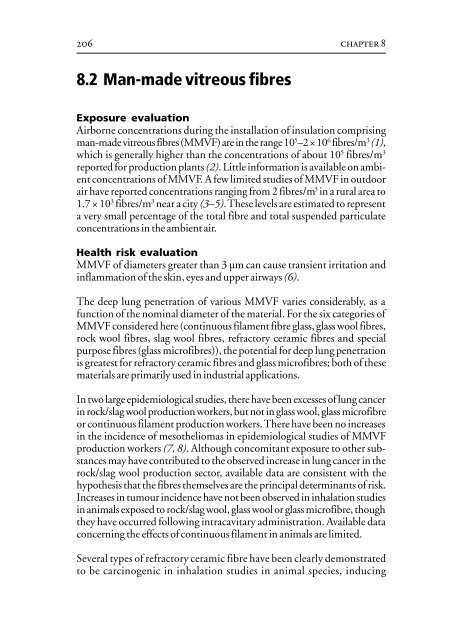Air Quality Guidelines - World Health Organization Regional Office ...
Air Quality Guidelines - World Health Organization Regional Office ...
Air Quality Guidelines - World Health Organization Regional Office ...
Create successful ePaper yourself
Turn your PDF publications into a flip-book with our unique Google optimized e-Paper software.
206 chapter 8<br />
8.2 Man-made vitreous fibres<br />
Exposure evaluation<br />
<strong>Air</strong>borne concentrations during the installation of insulation comprising<br />
man-made vitreous fibres (MMVF) are in the range 10 5 –2 × 10 6 fibres/m 3 (1),<br />
which is generally higher than the concentrations of about 10 5 fibres/m 3<br />
reported for production plants (2). Little information is available on ambient<br />
concentrations of MMVF. A few limited studies of MMVF in outdoor<br />
air have reported concentrations ranging from 2 fibres/m 3 in a rural area to<br />
1.7 × 10 3 fibres/m 3 near a city (3–5). These levels are estimated to represent<br />
a very small percentage of the total fibre and total suspended particulate<br />
concentrations in the ambient air.<br />
<strong>Health</strong> risk evaluation<br />
MMVF of diameters greater than 3 µm can cause transient irritation and<br />
inflammation of the skin, eyes and upper airways (6).<br />
The deep lung penetration of various MMVF varies considerably, as a<br />
function of the nominal diameter of the material. For the six categories of<br />
MMVF considered here (continuous filament fibre glass, glass wool fibres,<br />
rock wool fibres, slag wool fibres, refractory ceramic fibres and special<br />
purpose fibres (glass microfibres)), the potential for deep lung penetration<br />
is greatest for refractory ceramic fibres and glass microfibres; both of these<br />
materials are primarily used in industrial applications.<br />
In two large epidemiological studies, there have been excesses of lung cancer<br />
in rock/slag wool production workers, but not in glass wool, glass microfibre<br />
or continuous filament production workers. There have been no increases<br />
in the incidence of mesotheliomas in epidemiological studies of MMVF<br />
production workers (7, 8). Although concomitant exposure to other substances<br />
may have contributed to the observed increase in lung cancer in the<br />
rock/slag wool production sector, available data are consistent with the<br />
hypothesis that the fibres themselves are the principal determinants of risk.<br />
Increases in tumour incidence have not been observed in inhalation studies<br />
in animals exposed to rock/slag wool, glass wool or glass microfibre, though<br />
they have occurred following intracavitary administration. Available data<br />
concerning the effects of continuous filament in animals are limited.<br />
Several types of refractory ceramic fibre have been clearly demonstrated<br />
to be carcinogenic in inhalation studies in animal species, inducing

















